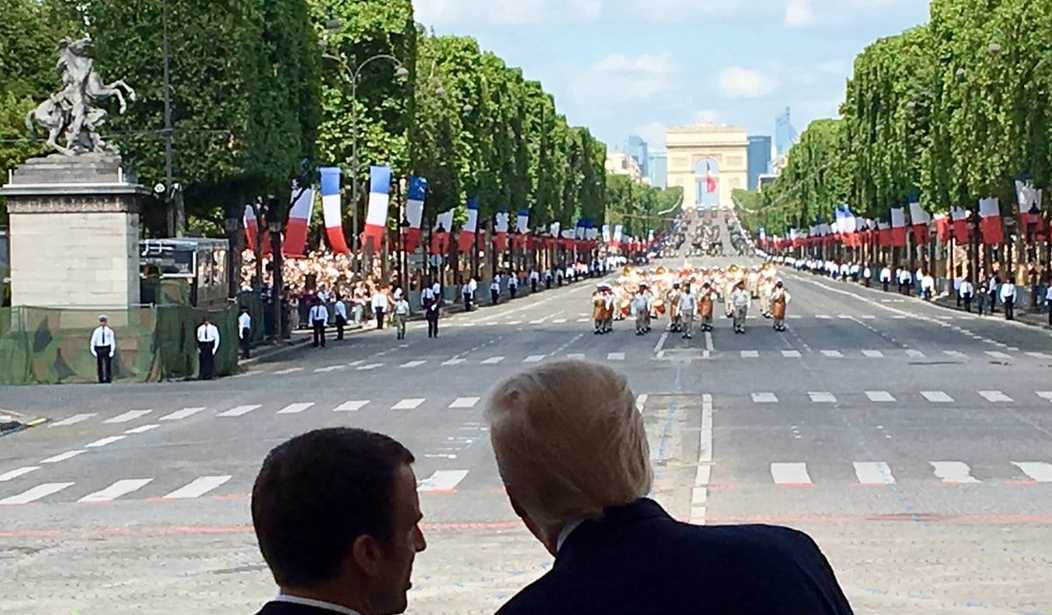On Friday, President Donald Trump marched with French President Emmanuel Macron in a magnificent Bastille Day parade. The parade marked 100 years since the U.S. entered World War I, and one year since the terror attack in Nice. But Bastille Day is a celebration of the French Revolution, which was very different from the American one.
“It was a great honor to represent the United States at the magnificent Bastille Day parade. Congratulations President Emmanuel Macron!” Trump tweeted, along with a picture of himself and Macron walking down Paris’ majestic Champs-Élysées.
It was a great honor to represent the United States at the magnificent #BastilleDay parade. Congratulations President @EmmanuelMacron! pic.twitter.com/1J4vZiy98y
— Donald J. Trump (@realDonaldTrump) July 14, 2017
Thousands of French troops took part in the parade, along with 241 horses, 63 airplanes, 29 helicopters, and 150 U.S. soldiers, airmen, sailors, and Marines, in addition to American aircraft.
Interestingly, Macron — a man not known for championing French values — declared that “on this national day of celebration, we must not ever forget the price that we paid for conquering, for winning our rights.”
“The price which we are prepared to pay to defend them because it is they which unite us and make France what it is today,” the president added.
But that price was stark indeed. Bastille Day celebrates the storming of the Bastille military prison in 1789, a key point in the French Revolution. The prison represented the oppression of the upper classes, and was a key symbolic victory for the Fourth Estate, the lower classes which rose in rebellion.
The French ancien régime was indeed oppressive, and the people had suffered under King Louis XVIII and his predecessors. But the French Revolution differed in key ways from the American Revolution thirteen years earlier.
The American Revolution threw off the governance of Britain over the American colonies, but the Declaration of Independence arguably furthered the rights of Englishmen, and referenced God no fewer than four times.
The first American government (under the Articles of Confederation) failed, and the Constitution had its own tumultuous start, but the revolution succeeded because it was limited. The founders had a restrained view of liberty, under God.
As President John Adams argued, “we have no government armed with power capable of contending with human passions unbridled by morality and religion. Avarice, ambition, revenge, or gallantry, would break the strongest cords of our Constitution as a while goes through a net. Our Constitution was made only for a moral and religious people. It is wholly inadequate to the government of any other.”
The French Revolution, by contrast, threw off the yoke of God. Under successive governments, the revolutionaries not only executed priests and ransacked churches, but they also abolished the 7-day week and set up a new calendar with 1789 serving as the year one.
This unrestrained revolution also featured the killing of King Louis XVIII, thousands of French nobles, and even revolutionary leaders like Maximilien Robespierre.
The Declaration of the Rights of Man and Citizen, France’s version of a Declaration of Independence, leaves God out of the equation and set up a government on a less defined notion of rights. The French Revolution sought to overturn not just government but society, and revolutionary governments followed, one after another, with no ground of legitimacy but “the people.”
Eventually, a military commander by the name of Napoleon Bonaparte established an autocratic regime on the ashes of revolutionary governments, and after he was deposed the monarchy was restored.
It took the United States of America thirteen years after declaring independence from Britain to establish a new government which would last for over two centuries. France, by contrast, had one revolution after another.
The revolution depicted in the 2012 film Les Miserables, for instance, was not the first French Revolution of Bastille Day and 1789, but the second one. The current government of France is known as the Fifth Republic, and it began in 1958.
France is a part of the West, but its revolution rejected too much of the Western tradition. It should stand as a warning to those who would reject the heritage of Greece, Rome, and Jerusalem. Critiquing that tradition is an important part of the West, but rejecting it leads to violence.
Trump’s championing of Bastille Day contrasts with his powerful pro-Western speech in Warsaw, Poland. The latter was a full-throated defense of the Western tradition, while the former arguably compromised that somewhat.
Nevertheless, it is important to note that Trump’s Bastille Day celebration was also a celebration of America’s entry into World War I and an expression of solidarity with modern France, which has suffered so many terror attacks.
It was still a celebration of the French Revolution, however, and that revolution powerfully contrasted with the American version. Modern France is not that angry mob which killed priests, beheaded kings, and outlawed God. But that anti-God revolutionary rejection of Western tradition is alive and well among the modern Left, and that rejection deserves to be condemned.









Join the conversation as a VIP Member